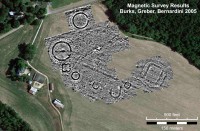 They had to pay through the nose with money they don’t actually have in hand quite yet, but the non-profit Arc of Appalachia, in collaboration with four other heritage and environmental organizations and donors like you and me, was able to purchase 193 acres of the Stark farm at auction on Tuesday, saving the ancient Hopewell earthworks known as the Junction Group. It’s an amazing result, especially when you consider that they only found out about the sale two weeks ago and the fundraising began eight days ago. They had to go up against some monied interests as well, housing developers who could have seriously damaged if not obliterated this sacred Native American ceremonial site.
They had to pay through the nose with money they don’t actually have in hand quite yet, but the non-profit Arc of Appalachia, in collaboration with four other heritage and environmental organizations and donors like you and me, was able to purchase 193 acres of the Stark farm at auction on Tuesday, saving the ancient Hopewell earthworks known as the Junction Group. It’s an amazing result, especially when you consider that they only found out about the sale two weeks ago and the fundraising began eight days ago. They had to go up against some monied interests as well, housing developers who could have seriously damaged if not obliterated this sacred Native American ceremonial site.
Arc of Appalachia was ambitiously hoping to buy the entire 335-acre farm even though the earthworks just take up about 25 acres of one 89-acre plot because they wanted to combine protected cultural heritage with a nature preserve. The farm was divided into six lots. Besides the earthworks field, the coalition was able to acquire two forested tracks and a river corridor 1.2 miles long. These additional lots were key to preserving the full archaeological context of the site and to protect the delicate ecosystem of the woods and along the environmentally significant Paint Creek. The only lot they did not acquire was a large farm field of more than 170 acres. That was their lowest priority parcel and it sold to Dave Williams, a farmer who has worked for the Stark family for 22 years.
 Williams was bummed that most of the land went to the conservancy groups. “I’m in it for one reason, they’re in it for another. Sad part is, when they buy property, there’s no more revenue from it, tax from it, that’s the downfall.” I wouldn’t call it a downfall since land isn’t wasted just because it’s not being used to produce cash crops. Even if you do think of its value solely in monetary terms, this is far from the end of the land’s ability to generate revenue for the state and local business alike. The opposite is true, in fact. The ultimate aim here, let’s recall, is to turn over the site to the Hopewell Culture National Historical Park, and the national parks are a huge source of money from fees and the many associated expenditures park visitors (hotels, restaurants, souvenirs) make. I doubt farm taxes even come close to park revenues.
Williams was bummed that most of the land went to the conservancy groups. “I’m in it for one reason, they’re in it for another. Sad part is, when they buy property, there’s no more revenue from it, tax from it, that’s the downfall.” I wouldn’t call it a downfall since land isn’t wasted just because it’s not being used to produce cash crops. Even if you do think of its value solely in monetary terms, this is far from the end of the land’s ability to generate revenue for the state and local business alike. The opposite is true, in fact. The ultimate aim here, let’s recall, is to turn over the site to the Hopewell Culture National Historical Park, and the national parks are a huge source of money from fees and the many associated expenditures park visitors (hotels, restaurants, souvenirs) make. I doubt farm taxes even come close to park revenues.
With real estate developers gunning for their piece of the pie, Arc of Appalachia wound up spending more than a million dollars to save this precious historical and environmental resource, $650,000 for the 90-acre earthworks lot alone.
Here’s some number crunching for you. We bought 102 acres of forest, the earthworks, and a total of 192 acres of land for a total of roughly $1.1 million. Our average per/acre cost was $5751.
As you can see, we raised roughly $375,000 through the generosity of over 900 donors, funds which we will use to leverage a Clean Ohio grant to pay the remaining balance of acquisition funds needed. If you pledged your support or would like to contribute, please send your donation now.
Obviously they’re very confident that the grant will be forthcoming or else they wouldn’t have gone so high, but the figures look very daunting to me so there’s still plenty of room for donations. Now that the land is secured, you can contribute to the kitty without fear that it will be for naught. Click the donate button on this page to make good on your pledge or to help keep Arc of Appalachia in the optimism to which it has become accustomed. If you’d like to mail in your pledged amount (or more), please send it to Arc of Appalachia, 7660 Cave Road, Bainbridge, OH 45612.
I pledged. I wouldn’t have heard about the Junction Group if it weren’t for your earlier post—so thank you! I’m happy to have been able to contribute to the preservation of such a fascinating site.
The “disappointment” of the land not making money brings back so many memories and reasons why Appalachia is the way it is. If we’re not seeing a direct profit from the environment why bother, even if it’s a pittance from corn or soy beans. Not to mention mining and farming take wealth OUT of the community where as a historical park, conservation, and tourism bring money IN.
You would think a not-so-natural disaster that just happened in West Virginia would make conservation the top priority but no, we need to see $5 per bushel of corn rather than know about our incredible past.
Glad to see this property is safe for now from development for housing/commercial. I have nothing against ‘developers’, per se, but in this particular case, it is truly unnecessary, move along.
I am from a farming community. It is good the other parcel went to Mr Williams. Please keep in mind his quote is actually out of context. He was frustrated/disappointed and the snippet does not convey what he intended.
Specifically, this was tillable ground he was farming, either leased or as a direct employee. Thus, his job has just been encroached/cut. Ouch.
Finding property to switch to is never simple. You need to farm as close to your home as possible- you don’t want to ‘commute’ via equipment to other properties somewhere else. It takes time to find properties available. His best situation was to try to buy what he was working on. Hopefully the transition goes smoothly.
I might add to readers, he will continue to be a neighbor to the locale.
Always be good to your neighbors~particularly when you are new to their neighborhood:) I wish everyone involved well!
Hurrah!
Glad they got it!My bigest fear was it would become yet ANOTHER sub-divsion of overpriced houses cheeply brafed up. But as a farmers dau. I feel for Mr Williams.It’s hard in some places for a man to get enough land to work to be a farmer in the sence that most would think of a “family farm”.Timmys family on “Lassie” and “The Real McCoys” etc.A situation made even worse when a established farm family sells off ther property in bit and pieces.Yes it gets more money for the family..but denies the local comunity of another generation of :chicken: young farmers.Then you here “Why dont our young folks stay around these parts?” Generaly becaues they cant out bid “deer trace tract houses” “quail holler trailer park” and “sprawll mart”.
Wonderful news. The History Blog alerted us to this, and we were able to help out a little. Thanks for your great work, and always-interesting blog.